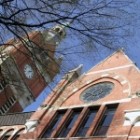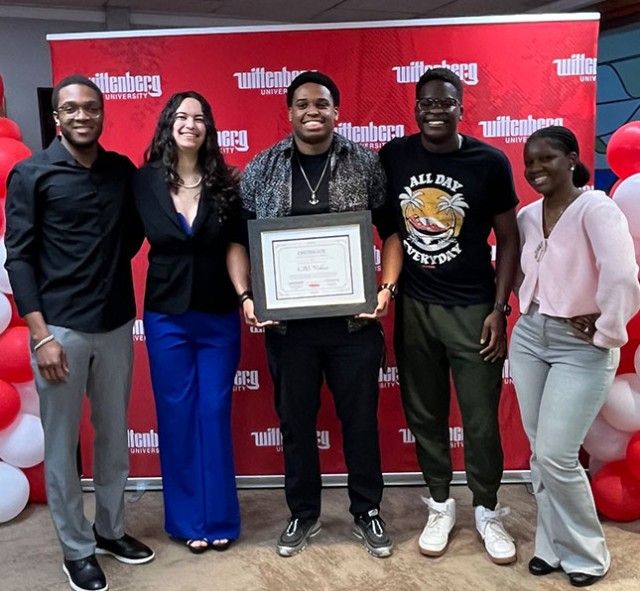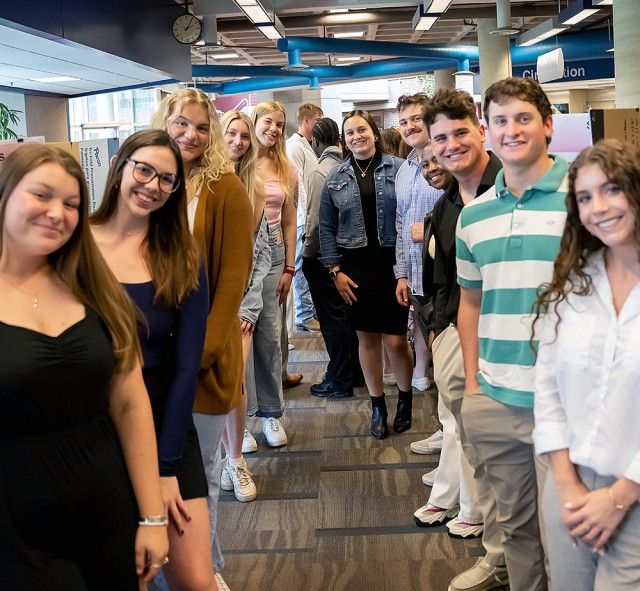A campus leader in classroom innovation and inquiry-based learning, Elizabeth George, professor of physics and department chair, can now add a national recognition to her impressive resume: the 2014 Ohio Professor of the Year.
Sponsored by the Council for the Advancement and Support of Education (CASE) and The Carnegie Foundation for the Advancement of Teaching, the U.S. Professor of the Year program is the only national program to recognize excellence in undergraduate education. Since the program’s founding in 1981, Wittenberg has led the state among four-year institutions in the number of professors receiving the coveted distinction. George’s award brings the official count to seven and shines the spotlight on Wittenberg’s superb teaching inside the classroom and outside of it. George’s honor also marks another milestone in Wittenberg history, as it has been nearly three decades since CASE awarded the distinction to the same institution two years in a row. Last year, John Ritter, professor of geology, earned the award.
Surprised, honored and deeply appreciative that faculty colleagues, administrators and former students nominated her for the award, George has insisted that the teaching of physics, and science in general, requires a commitment to hands-on learning and experimentation.
“We need to meet students where they are and encourage them to look at how the world behaves and then compare what they see to their own mental models,” said George, who helped implement research-based curricula such as RealTime Physics in her classrooms and labs.
“Making people aware of how much of everyday life revolves around physics is important,” she continued. “It’s also important for people to be able to ask questions and figure out how best to answer.”
George’s own curious nature and love of inquiry stem from her childhood experiences. Her dad taught mathematics at the University of Missouri at Columbia, and her mom taught Latin at the high school level. Both were dedicated to creating a home that encouraged problem-solving.
“My dad used to say, ‘I’ll give you a nickel if you can explain why this works that way.’”
While she isn’t sure how much she made off the childhood challenge, she recalls with ease some examples. On a family vacation to San Francisco, her dad pointed to the famous TransAmerica Pyramid, and then asked George and her sister what those squares were. George was nine at the time, and she quickly studied the structure, determined to figure it out. (Spoiler alert: elevator shafts) Her mom would do the same, dumping out utensil drawers to see what the girls could create.
“My mom said she knew I would be a scientist when she saw me taking apart the stroller and then trying to put it back together again,” George said.
Years later, George continues to bring that same level of inquiry into the lives of her students.
“Students need to have a chance to play with things, which is why it is so important to have labs where they can get their hands on things to experience something tactile, kinesthetic,” she explained.
An experimental nuclear physicist, George is also committed to matching students, regardless of intended major, with a research project of some consequence.
“I’m lucky to be in a department that is willing to try new things,” George said, adding that her department does really well at offering opportunities for student research and remaining open to student ideas.
“Students can be involved as early as they want to be, and we will work to find a project that matches their interest.”
To see this effort in action requires one to look no further than junior swimmer Thomas Chuna of Kettering, Ohio. Chuna approached George his first year on campus, long before declaring his major, about collaborative research options. That effort has since turned into a once-in-a-lifetime opportunity to work on an experiment exploring the properties of the nuclear weak force and its relationship to radioactive decay with top researchers at Michigan State next year. Such pursuits are critical as they have the potential to advance approaches being used in radiation therapy, PET scans and other medical imaging techniques.
The chance to work with undergraduates one-on-one – a hallmark of the Wittenberg experience, and the reason George wanted to work in a liberal arts setting despite earning her B.S. from the University of Arizona, her M.S. from the University of Colorado, and her Ph.D. from the University of Wisconsin-Madison – continues to inspire George to keep investigating the best practices for the teaching of science and to find ways to engage students from the start.
“I was the kid that enrolled in the science-kit-of-the-month program,” George said. “That is what science is and should be: the chance to play, to ask questions and to have fun. Physics is fun stuff.”
A nationally ranked university for the liberal arts and sciences affiliated with the Evangelical Lutheran Church in America, Wittenberg University has repeatedly been ranked throughout the years by the Princeton Review for the quality of its teaching and faculty, including 11th in the nation for “Best Classroom Experience” and 15th in the category “Professors Get High Marks” in the 2011 edition of Princeton’s annual Best Colleges guide. Most recently, Wittenberg earned the No. 4 spot in the category of “Most Accessible Professors.”
Additionally, The Chronicle of Higher Education named Wittenberg one of the nation’s top producers of Fulbright Scholars among bachelor degree-granting institutions in 2010. The university has also been recognized nationally for excellence in service and athletics.







